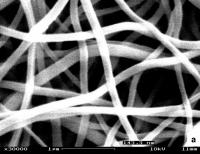University of Rochester researchers have created long platinum nanowires they claim could be used to develop commercially viable fuel cells.
The platinum nanowires produced by James C M Li, a professor of mechanical engineering, and his graduate student Jianglan Shui are roughly 10 nanometres in diameter and also centimetres in length - long enough to create a web of pure platinum that can serve as an electrode in a fuel cell.
By a process known as electrospinning - a technique used to produce long, ultra-thin solid fibres - Li and Shui were able to create the platinum nanowires, which are thousands of times longer than any previous such wires.
Within a fuel cell, a catalyst facilitates the reaction of hydrogen and oxygen, splitting compressed hydrogen fuel into electrons and hydrogen ions.
Electrons are then routed through an external circuit to supply power, while the hydrogen ions combine with electrons and oxygen to form the waste product, typically water.
Platinum has been the primary material used in making fuel cell catalysts because of its ability to withstand the harsh acidic environment inside the fuel cell.
Its energy efficiency is also substantially greater than that of cheaper metals such as nickel.
Prior efforts in making catalysts have relied heavily on platinum nanoparticles to maximise the exposed surface area of platinum.
The basic idea is simple: the greater the surface area, the greater the efficiency.
Li cites two main problems with the nanoparticle approach, both linked to the high cost of platinum.
First, individual particles can touch one another and merge through the process of surface diffusion, combining to reduce their total surface area and energy.
As surface area decreases, so too does the rate of catalysis inside the fuel cell.
Second, nanoparticles require a carbon-support structure to hold them in place.
Unfortunately, platinum particles do not attach particularly well to these structures and carbon is subject to oxidation and thus degradation.
As the carbon oxidises over time, more and more particles become dislodged and are permanently lost.
Li's nanowires avoid these problems completely.
With platinum arranged into a series of centimetre-long, flexible and uniformly thin wires, the particles comprising them are fixed in place and need no additional support.
Platinum will no longer be lost during normal fuel-cell operation.
'The reason people have not used nanowires before is that it's very hard to make them,' said Li.
'The parameters affecting the morphology of the wires are complex.
'And when they are not sufficiently long, they behave the same as nanoparticles.'
One of the key challenges Li and Shui managed to overcome was reducing the formation of platinum beads along the nanowires.
Without optimal conditions, instead of a relatively smooth wire, the wire looks more like a series of interspersed beads on a necklace.
'With platinum being so costly, it's quite important that none of it goes to waste when making a fuel cell,' said Li.
'We studied five variables that affect bead formation and we finally got it - nanowires that are almost bead free.'

Electron microscope view of platinum nanowires with beads

Electron microscope view of platinum nanowires without beads
His current objective is to further optimise laboratory conditions to obtain fewer beads and even longer, more uniformly thin nanowires.
'After that, we're going to make a fuel cell and demonstrate this technology,' said Li.




Glasgow trial explores AR cues for autonomous road safety
They've ploughed into a few vulnerable road users in the past. Making that less likely will make it spectacularly easy to stop the traffic for...